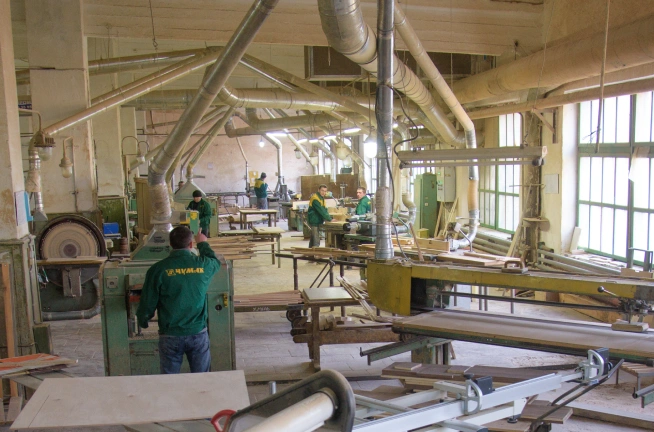- Lviv, 226 Kulparkivska str.
- Виробництво: 82011, Львівська обл., Самбірський р-н., смт. Нижанковичі, вул. Міцкевича, 97
Меню
Меню
Our production facilities are 1000 sq. meters. and located on an area of 2 hectares. More than 100 specialists are involved in the creation of furniture art objects, many of whom have been working at the factory for more than 15 years, and most of the craftsmen have gone a long way to perfection.
A distinctive feature of the factory is a completely closed production cycle: from the selection of tree trunks for cutting to the installation of finished products and after-sales service. We do all the work ourselves, without involving third parties. This allows us to be confident in the quality of the products we provide to our customers, architects and designers.

In carpentry production we use wood of various species: cherry, maple, ash, oak - the king of wood. We also use decorative exotic veneers. We use only 100% natural, natural and safe for health materials. The process of furniture making starts with the right choice of wood, healthy trunks, cutting at the appropriate time of year, careful preparation and their curing.
By following all technological processes, slowly drying the wood, we relieve internal stress in it, minimize deformation of the board and the likelihood of defects in the future finished product.
Natural drying of wood takes place by exposing the wood to air. The air drying technique consists mainly of the appropriate stacking of lumber (with layers of boards separated by laths) at a certain height from the ground (40-50 cm.), in a clean, cool and dry place.
The drying speed depends to a large extent on climatic conditions and air movement (wind).
Successful air drying requires a continuous and uniform flow of air over the entire mass of stacked wood.
For this purpose, the wood is placed in drying chambers equipped with equipment for manipulating and controlling the temperature, relative humidity, ventilation and circulation of the air. In drying chambers, as in natural drying, unsaturated air is used as a drying agent.
The successful operation of drying chambers can be achieved by adjusting the temperature and humidity of the circulating air at the proper time. This condition is achieved through the use of drying schedules.
The desired goal of the appropriate mode is to ensure that the lumber is dried at the highest possible speed without causing undesirable deformation of the wood.
We have taken great care in selecting the equipment for our workshops to ensure that it meets high standards of precision, manufacturability and reliability. In production we use:
The final stage of wood processing is called sanding. It is an important prerequisite for high-quality wood finishing with varnishes, paints, oils, etc.
Wood sanding is one of the most common methods of machining lumber, which is performed using abrasive hand tools (bars, paper, etc.) or a sander. In fact, the workpiece is exposed to abrasive surfaces on a cloth or paper basis.
All products are necessarily hand-ground only by our craftsmen, because only women can ensure uniformity, accuracy and fineness of grinding small details.
Wood carving is an art that the Slavs were famous for as far back as the 11th century.
Carving is a very delicate, time-consuming and responsible process, because one wrong move and the workpiece can become unsuitable for further processing.
Each carved element is unique because, depending on the radius and depth of the slot, the correct cutter must be used.
Mastery in wood carving is achieved through years of hard work, and many of our employees have been working in the factory for more than 10 years.
At the last stage, all products go through the manual grinding, painting, decorative finishing and varnishing department.
Depending on the product and the material it is made of, these processes may include additional steps.
The last stage in the production of any product is varnishing. Several layers of varnish not only provide additional protection against external damage, but also create the effect of a deeper and more saturated color, especially when using exotic veneers.
The final touch is the packaging of finished products and delivery to the warehouse. After that, you just have to meet our products at the agreed time and enjoy the perfect interior of your home for many decades!
Quality control in our joinery is carried out at many stages, but the most important one is dry assembly, when the finished elements are put together to make sure that all elements are made correctly and fit together perfectly. At the dry assembly stage, we check not only small joinery such as bedside tables, but also cabinets, kitchens and even staircases.
Also at this stage, we test the fittings in order to see any defects in advance and replace them at the factory. After all the tests have been passed, the products are disassembled and then polished and finished.
By cooperating with us, you get a unique result.